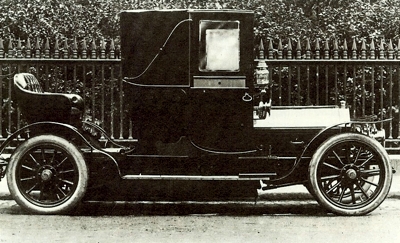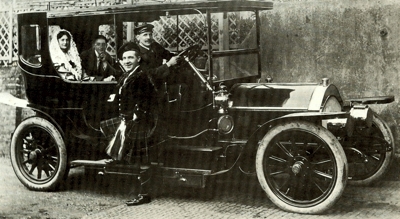Nagant was established by brothers Lean and Maurice, who owned an arms factory in Liege, Belgium, and, like many other turn-of-the-century armament makers, they turned to car manufacture as a relief from the long - and unprofitable - years of peace.
Their first products, which appeared in 1899-1900, were French Gobron-Brillies built under licence. Like their Gallic prototypes, these cars had their twin-cylinder opposed-piston engines set transversely at the rear of the chassis.
An 8 hp four soon followed, and these Gobron-Nagants were soon making their mark in local competitions; by 1902, they were appearing in international events, too. In the 1902 Paris-Vienna race, a team of two 18 hp Gobron-Nagants was entered. Identical to the contemporary Gobron-Brillie racers, these cars had twin-cylinder, 3.8-liter engines rated at 18 hp.
One of them, driven by the inappropriately named Dernier, came 11th in its class, 24th overall, and the other, driven by Conrard, finished 20th in its class and 38th in the general classification. The same combination of cars and drivers took part in the Circuit des Ardennes a month later. Dernier finished 13th, with Conrard 16th. And that, as far as competition went, was the end of Nagant involvement for several years
Before long, the Gobron-Nagant link was broken, and Nagant began producing conventional in-line four-cylinder models. The first of these, which appeared in 1906, was a chain-driven 35 hp model of 6872 cc but, once again, this was not an original design, for Nagant were now building Rochet-Schneiders under licence (these cars were also marketed under the Locomotrice banner).
The Nagant-Hobson
By 1906, the cars were being sold in England. H. M. Hobson Ltd, of Vauxhall Bridge Road, London, were appointed as agents, having already set up deals with Decauville cars, Pognon spark plugs and Jenatzy tyres. Hobson sold the new model on the British market as the Nagant-Hobson (and sometimes as plain Hobson) at a chassis price of £700. The standard Hobson-built tourer body added another £150 to the cost.
At the end of the following year a new Nagant-Hobson model was available-this was the 4589 cc 20/30 hp, priced at £475 in chassis form-while the 1908 Olympia Show saw the line-up increased to three models. Commented The Sphere. 'A car which has many friends is the Nagant-Hobson, made by Nagant Freres of Liege, which was remarkably successful in competitions during the year which is past. There is a new model of this for the man of moderate means - a 14 hp chassis selling at £350.
The other models are similar to those we know so well - the 25 hp and the famous 35 hp - the latter perhaps the speediest car for its horsepower that is made.' The new 14/18hp had a 2799cc engine, and was shown at Olympia in chassis form. The 35/40 was exhibited with a coupe landaulette body by Kellner of Paris, while the 20/30 had Laurie & Marner inside-driven landaulette coachwork. Both the larger models had dual ignition, while the 14/18 had magneto ignition only.
The following year there was added incentive to buy a Nagant...although the chassis price of the 14/18 remained at £350, the engine size was increased to 3053 cc (a still larger version of this model was available in 1913, with the engine stretched to 3308 cc). The old 35/40 Nagant was discontinued in 1911, but the next year saw a new light-car from the Liege works, in the shape of a 2001 cc 10/12 hp model, priced at £325 complete. In 1913, both the price and the engine capacity were reduced, the cost dropping to £300 while the swept volume became 1816 cc. By this time, it seems, Mr Hobson and the Nagant Freres had parted company, and Hobson was advertising another Belgian make, Excelsior.
 Nagant-Hobson 40hp chassis with Laurie and Marner body.
Nagant-Hobson 40hp chassis with Laurie and Marner body.
 Scottish entertainer Harry Lauder poses next to a Nagant-Hobson 35/40hp. Production started in 1906, and they used a 6872cc engine and chain-drive.
Scottish entertainer Harry Lauder poses next to a Nagant-Hobson 35/40hp. Production started in 1906, and they used a 6872cc engine and chain-drive. |
Nagant Return to Competition
Then, in 1914, came a surprising and spectacular return to competition, with the entry of two cars for the premier race of the calendar, the French Grand Prix at Lyon. To be driven by Leon Elskamp and Esser, the cars were a complete break from Nagant tradition, with twin overhead camshafts actuating four valves per cylinder, five speed gearboxes and multi-disc clutches; the swept volume was 4433 cc. Elskamp started third, but gradually slipped back down the field; Esser, starting seventeenth, began to move up, taking around 23 minutes to cover the 37.6 circuit, an average of around 62 mph.
He maintained this consistent performance throughout the twenty-lap race, finishing in sixth position, behind the Mercedes of Lautenschlager, Wagner and Salzer, the Peugeot of Goux and Dario Resta's Sunbeam. It was an unrepeatable high point of achievement. Within weeks, the invading German army had overrun Belgium and the Nagant factory had been sacked, in common with the other members of the Belgian motor industry.
Remarkably, the company was back in production by 1920 and, when the Chambre Syndicale des Constructeurs d'Automobiles et de Cycles de Belgique (of which Maurice Nagant was an Executive Committee member) held their first postwar Salon in Brussels from 10-19 December 1920, Nagant Freres were ready with a new model - the 16 hp, a 2996 cc four-cylinder model, produced initially with side valves, latterly with overhead inlet valves mounted in a detachable cylinder head.
Shortly afterwards came a sporting 1954 cc four with all valves overhead and, like all the best Belgian cars of the 1920s, Adex four-wheel braking. In 1925, an increase in bore size brought the swept volume to 2121 cc and, in that same year, the marque gained its last sporting success with two of these cars finishing first and second in the 3-liter class of the Belgian 24-hour race at Spa.
Two years later, at the Brussels Salon, Nagant showed a supercharged engine, but this was the shape of things that were not to come, for alongside it was introduced the final production Nagant, a dreary side-valve six-cylinder with Dewandre servo-assisted four-wheel brakes. Within the year, Nagant had been swallowed up by Imperia, and the company's factory at Quai de Couronmeuse, Liege, ceased production for all time.
